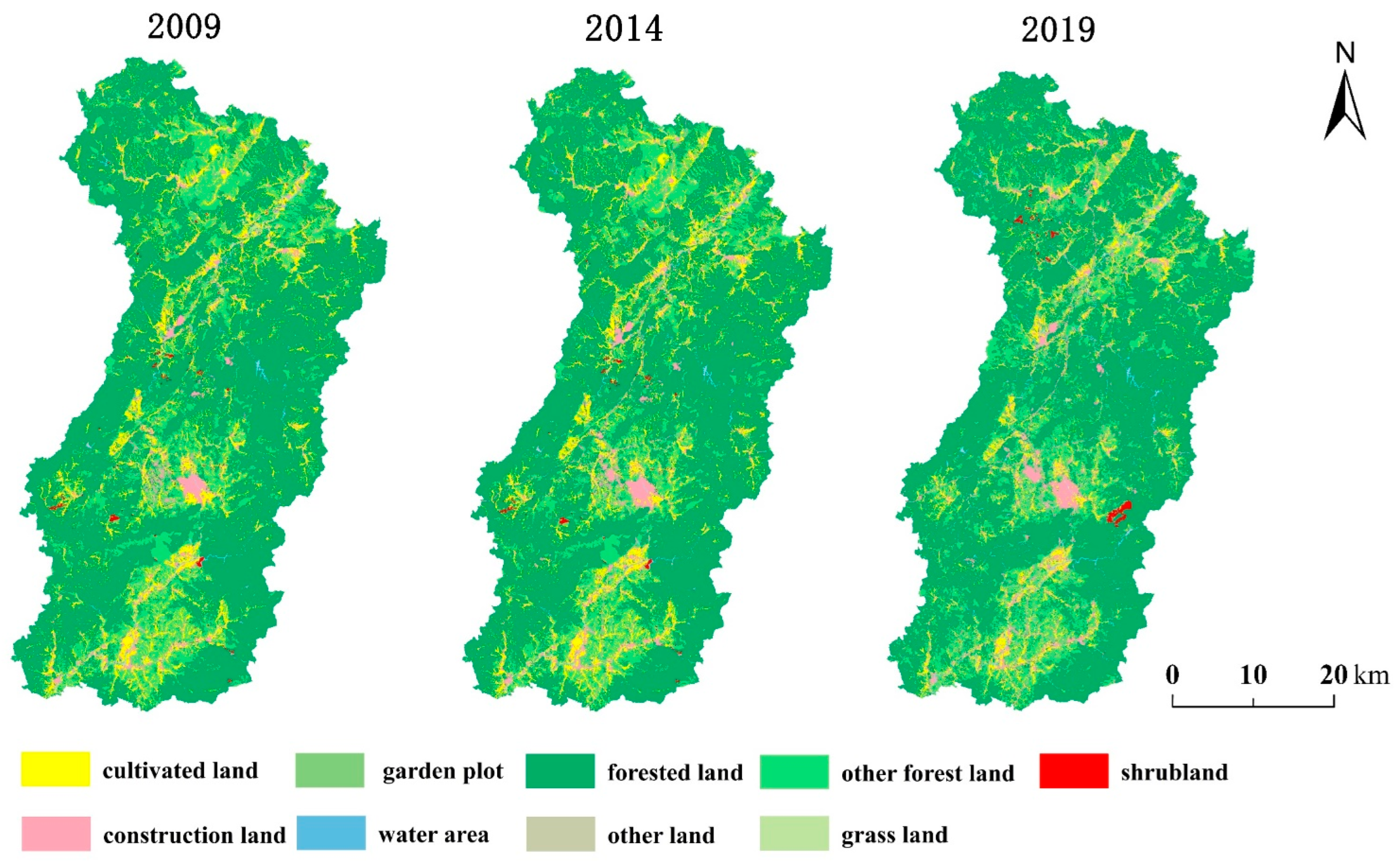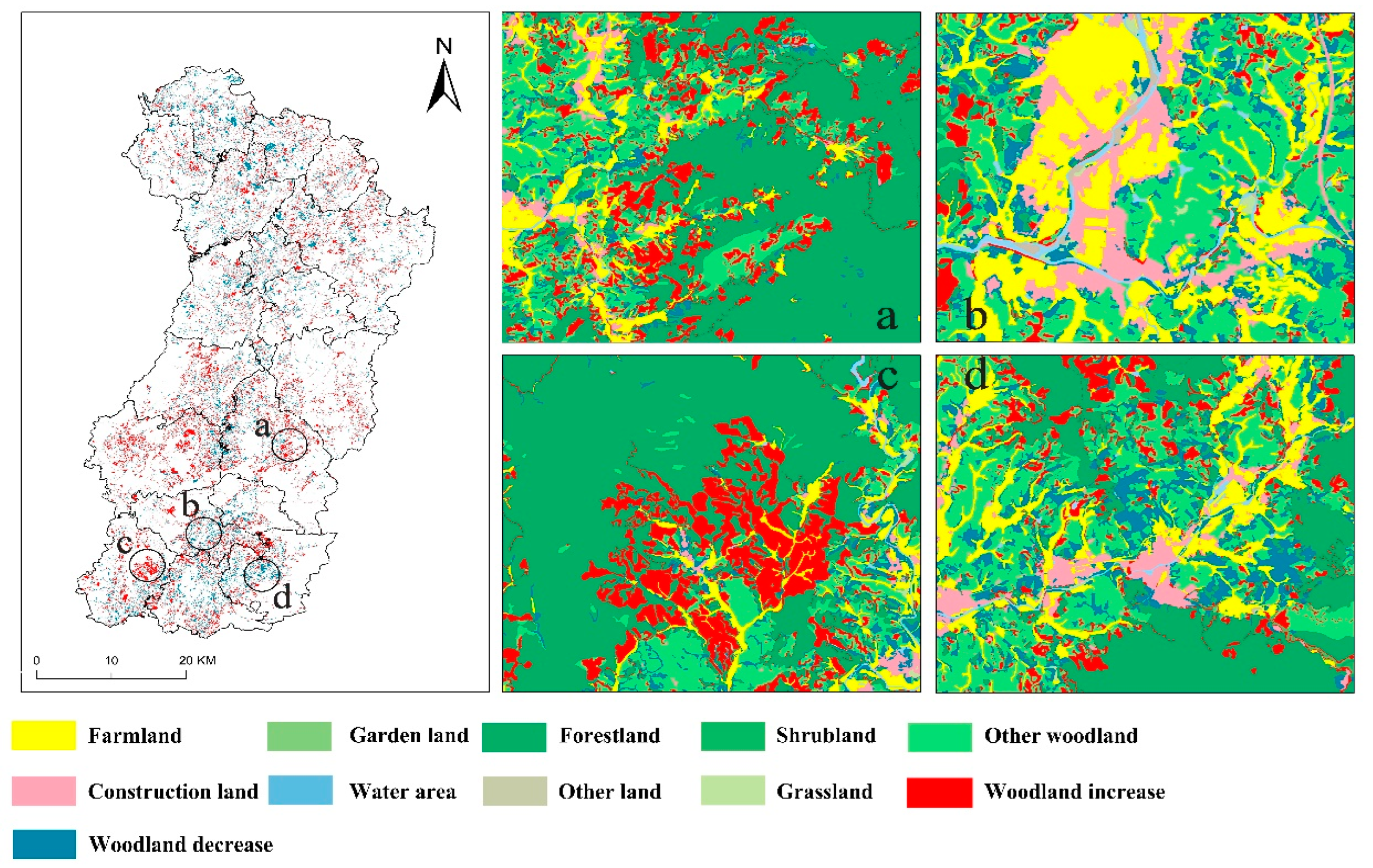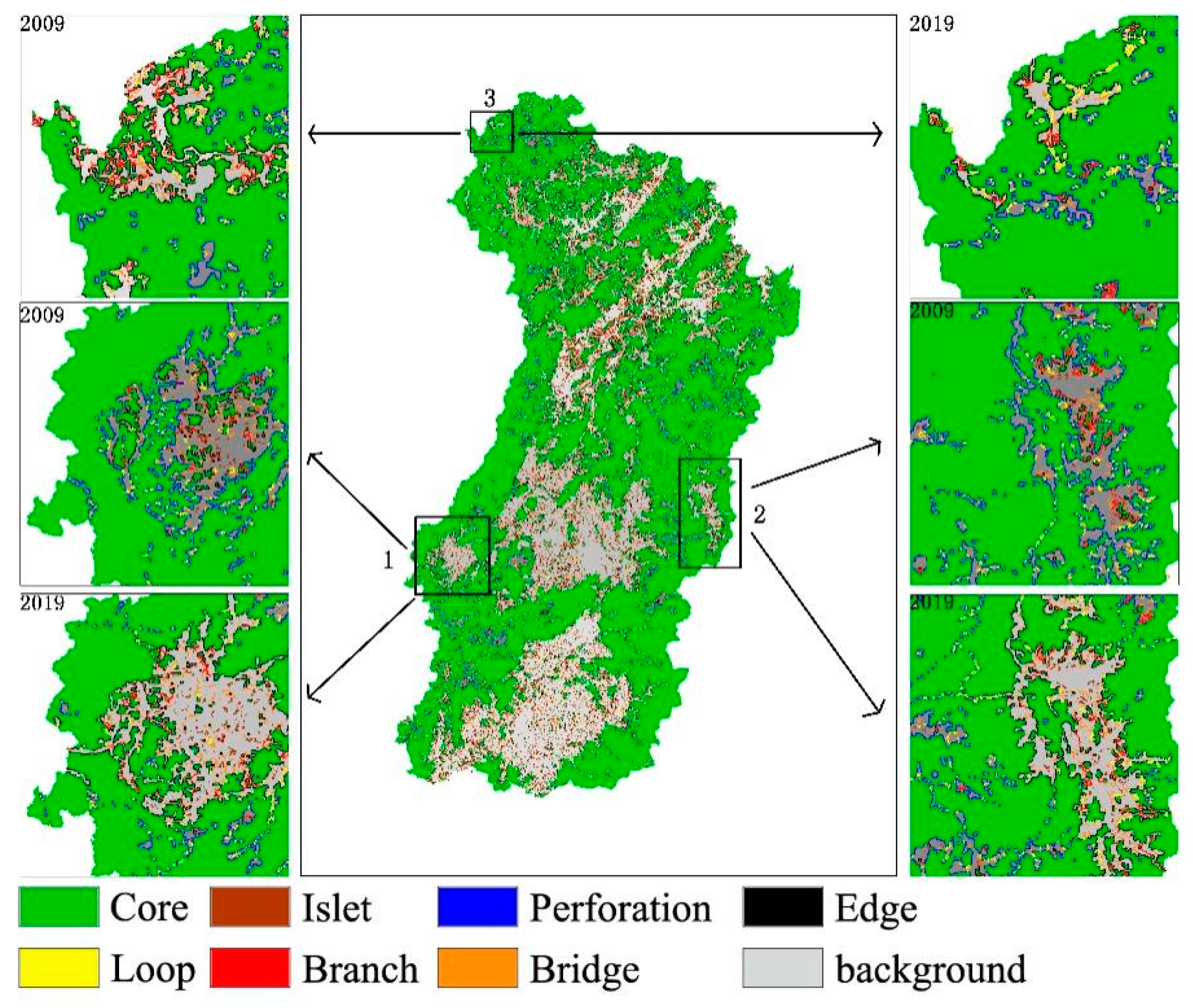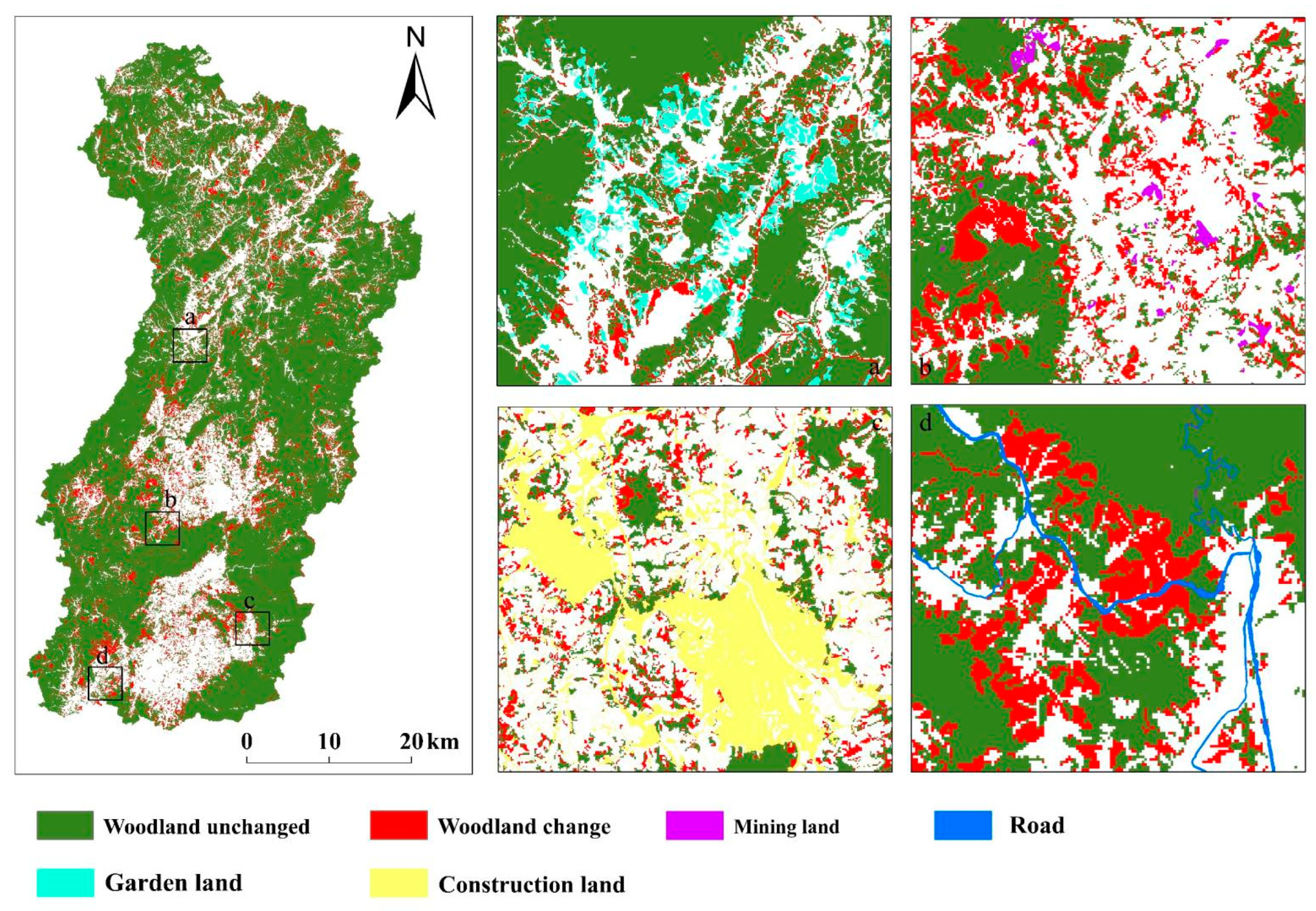Causes of Changing Woodland Landscape Patterns in Southern China
Abstract
1. Introduction
2. Materials and Methods
2.1. Study Area and Data Collection
2.2. Data Sources and Processing
2.3. Transfer Matrix-Based Analysis of Woodland Change
2.4. Selection of Landscape Pattern Indices
2.5. Morphological Spatial Pattern Analysis
2.6. Logistic Regression Model
3. Results
3.1. Woodland Transfer in Anyuan County
3.2. Landscape Pattern Change of Woodlands
3.2.1. Landscape Pattern Change at the Patch Level
3.2.2. Landscape Pattern Change at the Landscape Level
3.3. Morphological Spatial Patterns of Woodlands
3.4. Logistic Regression Analysis of Woodland Change
4. Discussion
5. Conclusions
Author Contributions
Funding
Institutional Review Board Statement
Informed Consent Statement
Data Availability Statement
Acknowledgments
Conflicts of Interest
References
- Minerva, S.; Evans, D.; Chevance, J.-B.; Tan, B.S.; Wiggins, N.; Kong, L.; Sakhoeun, S. Evaluating the ability of community-protected forests in Cambodia to prevent deforestation and degradation using temporal remote sensing data. Ecol. Evol. 2018, 8, 10175–10191. [Google Scholar]
- Acero-Murcia, A.C.; Amaral, F.R.D.; de Barros, F.C.; Ribeiro, T.D.S.; Miyaki, C.Y.; Maldonado-Coelho, M. Ecological and evolutionary drivers of geographic variation in songs of a Neotropical suboscine bird: The Drab-breasted Bamboo Tyrant (Hemitriccus diops, Rhynchocyclidae). Ornithology 2021, 138, ukab003. [Google Scholar] [CrossRef]
- Lynch, L.; Kokou, K.; Todd, S. Comparison of the ecological value of sacred and nonsacred community forests in Kaboli, Togo. Trop. Conserv. Sci. 2018, 11, 194008291875827. [Google Scholar] [CrossRef]
- Krupskaya, L.T.; Gul, L.P.; Filatova, M.Y.; A Romashkina, E.; A Kolobanov, K. Problems and prospects for forest restoration, conservation and protection by reclamation during mineral development in the far eastern federal district. IOP Conf. Ser. Earth Environ. Sci. 2021, 876, 012046. [Google Scholar] [CrossRef]
- Alexis, A.; Moreau, G.; Coops, N.C.; Axelson, J.N.; Barrette, J.; Bédard, S.; Byrne, K.E.; Caspersen, J.; Dick, A.R.; D’Orangeville, L.; et al. The changing culture of silviculture. For. Int. J. For. Res. 2022, 95, 143–152. [Google Scholar]
- Adebayo, W.A. Environmental law and the reality of the conservation and management of forests in Nigeria. J. Law Policy Glob. 2020, 96. [Google Scholar] [CrossRef]
- Paula, R.R.; Calmon, M.; Lopes-Assad, M.L.; Mendonça, E.D.S. Soil organic carbon storage in forest restoration models and environmental conditions. For. Res. Engl. Ed. 2022, 33, 12. [Google Scholar] [CrossRef]
- Eliana, M.; Valeria, O.; Martin, M.; Girona, M.M.; Ramirez, J.A.C. Long-term impacts of forest management practices under climate change on structure, composition, and fragmentation of the Canadian boreal landscape. Forests 2022, 13, 1292. [Google Scholar] [CrossRef]
- Zhang, M.; Wang, J.; Li, S.; Feng, D.; Cao, E. Dynamic changes in landscape pattern in a large-scale opencast coal mine area from 1986 to 2015: A complex network approach. Catena 2020, 194, 10483. [Google Scholar] [CrossRef]
- Tang, Q.; Li, J.; Tang, T.; Liao, P.; Wang, D. Construction of a forest ecological network based on the forest ecological suitability index and the morphological spatial pattern method: A case study of jindong forest farm in Hunan Province. Sustainability 2022, 14, 3082. [Google Scholar] [CrossRef]
- Ørka, H.O.; Jutras-Perreault, M.-C.; Næsset, E.; Gobakken, T. A framework for a forest ecological base map—An example from Norway. Ecol. Indic. 2022, 136, 108636. [Google Scholar] [CrossRef]
- Hof, A.R.; Girona, M.M.; Fortin, M.-J.; Tremblay, J.A. Editorial: Using landscape simulation models to help balance conflicting goals in Changing Forests. Front. Ecol. Evol. 2021. [Google Scholar] [CrossRef]
- Guga, S.; Xu, J.; Riao, D.; Li, K.; Han, A.; Zhang, J. Combining MaxEnt model and landscape pattern theory for analyzing interdecadal variation of sugarcane climate suitability in Guangxi, China. Ecol. Indic. 2021, 131, 108152. [Google Scholar] [CrossRef]
- Tao, W.; Zha, P.; Yu, M.; Jiang, G.; Zhang, J.; You, Q.; Xie, X. Landscape pattern evolution and its response to human disturbance in a newly metropolitan area: A case study in Jin-Yi Metropolitan Area. Land 2021, 10, 767. [Google Scholar]
- Coops, N.C.; Gillanders, S.N.; Wulder, M.A.; Gergel, S.E.; Nelson, T.; Goodwin, N.R. Assessing changes in forest fragmentation following infestation using time series Landsat imagery. For. Ecol. Manag. 2010, 259, 2355–2365. [Google Scholar] [CrossRef]
- Liu, Y.; Cao, X.; Li, T. Influence of accessibility on land use and landscape pattern based on mapping knowledge domains: Review and implications. J. Adv. Transp. 2020, 2020, 7985719. [Google Scholar] [CrossRef]
- Chen, B.; Xie, M.; Feng, Q.; Li, Z.; Chu, L.; Liu, Q. Heat risk of residents in different types of communities from urban heat-exposed areas. Sci. Total Environ. 2021, 768, 145052. [Google Scholar] [CrossRef]
- Xiao, Z.T.; Zhang, W.Y.; Hao, L.J. The evolution of spatial and temporal patterns of Zhengzhou ecological network based on MSPA. Arab. J. Geosci. 2021, 14, 1107. [Google Scholar]
- Tang, F.; Zhou, X.; Wang, L.; Zhang, Y.; Fu, M.; Zhang, P. Linking ecosystem service and MSPA to construct landscape ecological network of the Huaiyang Section of the Grand Canal. Land 2021, 10, 919. [Google Scholar] [CrossRef]
- Mostafizur, R.M.; György, S. Impact of land use and land cover changes on urban ecosystem service value in Dhaka, Bangladesh. Land 2021, 10, 793. [Google Scholar]
- Zhao, Y.; Ren, H.; Li, X. Forest transition and its driving forces in the Qian-Gui Karst Mountainous Areas. J. Resour. Ecol. 2020, 11, 59. [Google Scholar]
- Zhang, X.; Yao, J.; Wang, J.; Sila-Nowicka, K. Changes of forestland in China’s coastal areas (1996–2015): Regional variations and driving forces. Land Use Policy 2020, 99, 105018. [Google Scholar] [CrossRef]
- Wang, H.; Yu, W.; Chen, T.; Yu, S.; Zhang, S. Study on the temporal-spatial evolution rules of inter-provincial eco-efficiency in China. Environ. Eng. Manag. J. 2020, 19, 2255–2261. [Google Scholar] [CrossRef]
- Chen, Y.; Fu, M.; Feng, D.; Sun, Y.; Zhai, G. Spatiotemporal changes in vegetation cover and its influencing factors in the loess plateau of China based on the geographically weighted regression model. Forests 2021, 12, 673. [Google Scholar]
- Sneha, B.; Novo, L.A.B.; Pietrzykowski, M.; Maiti, S.K. Assessment of forest ecosystem development in coal mine degraded land by using Integrated Mine Soil Quality Index (IMSQI): The evidence from India. Forests 2020, 11, 1310. [Google Scholar]
- Dagnachew, M.; Kebede, A.; Moges, A.; Abebe, A. Land use land cover changes and its drivers in Gojeb River Catchment, Omo Gibe Basin, Ethiopia. Environ. Sci. 2020, 114, 33–56. [Google Scholar]
- Chen, X.; Li, F.; Li, X.; Hu, Y.; Hu, P. Quantifying the compound factors of forest land changes in the Pearl River Delta, China. Remote Sens. 2021, 13, 1911. [Google Scholar] [CrossRef]
- Xia, C.; Chen, B. Urban land-carbon nexus based on ecological network analysis. Appl. Energy 2020, 276, 115465. [Google Scholar] [CrossRef]
- Zhang, X.; Huang, B.; Liu, F. Information extraction and dynamic evaluation of soil salinization with a remote sensing method in a typical county on the Huang-Huai-Hai Plain of China. Pedosphere 2020, 30, 496–507. [Google Scholar] [CrossRef]
- Liu, S.; Sun, Y.; Wu, X.; Li, W.; Liu, Y.; Tran, L.S.-P. Driving factor analysis of ecosystem service balance for watershed management in the Lancang River Valley, Southwest China. Land 2021, 10, 522. [Google Scholar] [CrossRef]
- Ai, J.; Yu, K.; Zeng, Z.; Yang, L.; Liu, Y.; Liu, J. Assessing the dynamic landscape ecological risk and its driving forces in an island city based on optimal spatial scales: Haitan Island, China. Ecol. Indic. 2022, 137, 108771. [Google Scholar] [CrossRef]
- Berila, A.; Isufi, F. Two decades (2000–2020) measuring urban sprawl using GIS, RS and landscape metrics: A case study of Municipality of Prishtina (Kosovo). J. Ecol. Eng. 2021, 22, 114–125. [Google Scholar] [CrossRef]
- Yushanjiang, A.; Zhang, F.; Yu, H.; Kung, H.-T. Quantifying the spatial correlations between landscape pattern and ecosystem service value: A case study in Ebinur Lake Basin, Xinjiang, China. Ecol. Eng. 2018, 113, 94–104. [Google Scholar] [CrossRef]
- Zhang, Q.; Chen, C.; Wang, J.; Yang, D.; Zhang, Y.; Wang, Z.; Gao, M. The spatial granularity effect, changing landscape patterns, and suitable landscape metrics in the Three Gorges Reservoir Area, 1995–2015. Ecol. Indic. 2020, 114, 106259. [Google Scholar] [CrossRef]
- Grafius, D.R.; Corstanje, R.; Harris, J.A. Linking ecosystem services, urban form and green space configuration using multivariate landscape metric analysis. Landsc. Ecol. 2018, 33, 557–573. [Google Scholar] [CrossRef] [PubMed]
- Huang, X.-Y.; Ye, Y.-H.; Zhang, Z.-Y.; Ye, J.-X.; Gao, J.; Bogonovich, M.; Zhang, X. A township-level assessment of forest fragmentation using morphological spatial pattern analysis in Qujing, Yunnan Province, China. J. Mt. Sci. Engl. Ed. 2021, 18, 13. [Google Scholar] [CrossRef]
- Wang, T.; Ren, Y. Optimization of green infrastructure network in fengdong new town based on MSPA and MCR model. Sci. Discov. 2021, 9, 226. [Google Scholar] [CrossRef]
- Carlier, J.; Davis, E.; Ruas, S.; Byrne, D.; Caffrey, J.M.; Coughlan, N.E.; Dick, J.T.; Lucy, F.E. Using open-source software and digital imagery to efficiently and objectively quantify cover density of an invasive alien plant species. J. Environ. Manag. 2020, 266, 110519. [Google Scholar] [CrossRef]
- Yang, Z.G.; Jiang, Z.Y.; Guo, C.X.; Yang, X.J.; Xu, X.J.; Li, X.; Hu, Z.M.; Zhou, H.Y. Construction of ecological network using morphological spatial pattern analysis and minimal cumulative resistance models in Guangzhou City, China. Chin. J. Appl. Ecol. 2018, 29, 3367–3376. [Google Scholar]
- Yong, Y.; Tai, S.; Bao, X. Scale effect of Nanjing urban green infrastructure network pattern and connectivity analysis. J. Appl. Ecol. 2016, 27, 2119–2127. [Google Scholar]
- Soille, P.; Vogt, P. Morphological segmentation of binary patterns. Pattern Recognit. Lett. 2008, 30, 456–459. [Google Scholar] [CrossRef]
- Sun, J.; Southworth, J. Indicating structural connectivity in Amazonian rainforests from 1986 to 2010 using morphological image processing analysis. Int. J. Remote Sens. 2013, 34, 5187–5200. [Google Scholar] [CrossRef]
- Badra, H.M.; Hearath, S. Geospatial assessment on land-use changes of Home Gardens in Upper Mahaweli Catchment in Sri Lanka. Vidyodaya J. Humanit. Soc. Sci. 2021, 6, 83–98. [Google Scholar] [CrossRef]
- Jiaxing, X.; Gang, L.; Guoliang, C. Analysis of the driving forces of land use evolution in mining areas based on logistic regression models. J. Agric. Eng. 2012, 28, 247–255. [Google Scholar]
- Xu, X.; Sinha, S.K. Robust designs for generalized linear mixed models with possible model misspecification. J. Stat. Plan. Inference 2021, 210, 20–41. [Google Scholar] [CrossRef]
- Xing, W.; Qian, Y.; Guan, X.; Yang, T.; Wu, H. A novel cellular automata model integrated with deep learning for dynamic spatio-temporal land use change simulation. Comput. Geosci. 2020, 137, 104430. [Google Scholar] [CrossRef]
- Xu, Y.; Tian, Q.Y.; Li, S.P. Spatial simulation of land use change drivers and construction land increase in Zhangjiakou City based on logistic regression model. J. Peking Univ. 2015, 51, 955–964. [Google Scholar]
- Li, Y.; Han, M. Study on the transformation of arable land trajectory and driving forces in the Yellow River Delta in the last 30 years. China Popul. Resour. Environ. 2019, 29, 136–143. [Google Scholar]
- Xie, H.; Li, B. Analysis of the driving forces of land use change in the agro-pastoral interlacing area based on logistic regression model—Wengniut Banner in Inner Mongolia as an example. Geogr. Res. 2008, 2, 294–304. [Google Scholar]
- Hou, L.; Wu, F.; Xie, X. The spatial characteristics and relationships between landscape pattern and ecosystem service value along an urban-rural gradient in Xi’an city, China. Ecol. Indic. 2020, 108, 105720. [Google Scholar] [CrossRef]
- Li, J.; Li, S.; Huang, X.; Tang, R.; Zhang, R.; Li, C.; Xu, C.; Su, J. Plant diversity and soil properties regulate the microbial community of monsoon evergreen broad-leaved forest under different intensities of woodland use. Sci. Total Environ. 2022, 821, 153565. [Google Scholar] [CrossRef] [PubMed]
- Liu, D.; Li, S.; Fu, D.; Shen, C. Remote sensing analysis of mangrove distribution and dynamics in Zhanjiang from 1991 to 2011. J. Oceanol. Limnol. 2018, 36, 1597–1603. [Google Scholar] [CrossRef]
- Yuanjie, D. Logistic regression model-based analysis of the driving forces of forest land change in the Qinba Mountains of Shaanxi. J. Nanjing For. Univ. 2022, 46, 106–114. [Google Scholar]
- Girona, M.; Rossi, S.; Lussier, J.M.; Walsh, D.; Morin, H. Understanding tree growth responses after partial cuttings: A new approach. PLoS ONE 2017, 12, e0172653. [Google Scholar]
- Xie, H.; He, Y.; Zhang, N. Spatiotemporal changes and fragmentation of forest land in Jiangxi Province, China. J. For. Econ. 2017, 29, 4–13. [Google Scholar] [CrossRef]





| Data | Source |
|---|---|
| Land survey data | The Natural Resources Bureau of Anyuan County |
| Digital elevation model (DEM) data | The Geospatial Data Cloud (http://www.gscloud.cn, 17 August 2022) |
| Soil texture and soil type maps | The corresponding maps of Jiangxi Province |
| Socio-economic data | The Anyuan County Statistical Yearbook |
| Index | Calculation Formula | Parameter Description and Ecological Connotations |
|---|---|---|
| Number of patches (NP) | NP is obtained using ArcGIS v10.6. | It is positively correlated with landscape fragmentation. |
| Aggregation index (AI) | The gii is the number of similar neighboring patches of the corresponding landscape type. The smaller the AI value, the more dispersed the land landscape is. | |
| Landscape shape index (LSI) | The A and L are the mean area and perimeter of patches, respectively. The smaller the Sc value, the more regular and simpler the shape of the patches and landscape. | |
| Patch density (PD) | N is the number of patches and A is the total area of the landscape or patches. The larger the Pd value, the greater the fragmentation of the landscape. | |
| Largest patch index (LPI) | amax is the area of the largest patch in the landscape or patch type, while A is the total area of the landscape. The LPI determines the dominant patch type in the landscape. | |
| Edge density (ED) | E is the total length of the edge of all patches, and A is the total area of the landscape. The ED value is highest when the components account for equal proportions. | |
| Shannon diversity (SHDI) | Pi is the proportion of landscape patch type i. Higher SHDI values indicate a more balanced distribution of patch types in the landscape. |
| Morphological Spatial Pattern | Definition | Ecological Connotations |
|---|---|---|
| Core | A set of pixels with foreground pixels that are far away from background pixels, at a distance larger than the specified value for a certain parameter. | Larger habitat patches in the foreground pixel provide larger habitats for species, which are essential for biodiversity conservation and are source sites in the ecological network. |
| Islet | Patches that are not connected to any foreground areas and that are smaller than the minimum threshold of the core area. | Small, isolated, and fragmented patches that are not connected to each other, have low connectivity between patches, and low potential for internal exchange and transfer of material and energy. |
| Perforation | A hole inside the central area, with the edge outside the foreground made up of the background. | It is a transition area between the core and non-green landscape patches, namely internal patch edges (edge effects). |
| Edge | The edge outside the foreground. | It is a transition area between the core area and the major non-green landscape areas. |
| Bridge | At least two points connected to different cores. | The narrow area linked to the core area represents a corridor connecting patches in the ecological network, which is crucial for biological migration and landscape connectivity. |
| Loop | At least two points connected to the same core area. | Corridors connecting the same core area are shortcuts for species migration within the same core area. |
| Branch | Only one side is connected to the edge, bridge, or loop. | Areas that are only connected at one end to an edge, bridge, loop, or perforation. |
| Driving Force Index | Variables | Types of Variables | Units |
|---|---|---|---|
| Dependent variable | Woodland change (Y) | Secondary classification | 0, 1 |
| Natural drivers | Elevation (X1) | Continuous type | m |
| Slope (X2) | Multi-category | I~V | |
| Soil type (X3) | Multi-category | I~V | |
| Temperature (X4) | Continuous type | °C | |
| Precipitation (X5) | Continuous type | mm | |
| Geographical location drivers | Distance to road (X6) | Continuous type | m |
| Distance to town (X7) | Continuous type | m | |
| Distance to rural settlements (X8) | Continuous type | m | |
| Distance to orchards (X9) | Continuous type | m | |
| Distance to industrial and mining sites (X10) | Continuous type | m | |
| Socio-economic drivers | Population density (X11) | Continuous type | Person/km2 |
| Navel orange and citrus production (X12) | Continuous type | t |
| Woodland Type | Woodland Area | Change Over Time | ||||
|---|---|---|---|---|---|---|
| 2009 | 2014 | 2019 | 2009–2014 | 2014–2019 | 2009–2019 | |
| Forestland | 158,503.17 | 157,976.33 | 155,439.01 | −526.83 | −2537.32 | −3064.15 |
| Shrubland | 495.31 | 486.07 | 645.18 | −9.24 | 159.11 | 149.88 |
| Other woodland | 19,865.19 | 19,727.51 | 17,820.19 | −137.68 | −1907.32 | −2044.99 |
| Total | 178,863.66 | 178,189.92 | 173,904.39 | −673.74 | −4285.52 | −4959.27 |
| Woodland Type | Transfer Direction | Farmland | Garden Land | Construction Land | Water Area | Grassland | Other Land | Total |
|---|---|---|---|---|---|---|---|---|
| Forestland | Transfer-out | 1154.46 | 8484.33 | 2447.94 | 731.19 | 60.43 | 6.01 | 12,884.36 |
| Transfer-in | 1986.44 | 4235.68 | 465.83 | 120.25 | 433.76 | 113.81 | 7355.77 | |
| Shrubland | Transfer-out | 9.94 | 74.02 | 21.53 | 8.88 | 1.38 | 0.00 | 115.75 |
| Transfer-in | 20.00 | 24.35 | 3.84 | 0.97 | 3.66 | 1.08 | 53.90 | |
| Other woodland | Transfer-out | 307.23 | 2442.28 | 613.64 | 147.74 | 18.57 | 4.68 | 3534.14 |
| Transfer-in | 1190.31 | 2187.52 | 343.32 | 78.13 | 297.73 | 68.29 | 4165.30 | |
| Total | Transfer-out | 1471.63 | 11,000.62 | 3083.11 | 887.81 | 80.37 | 10.69 | 16,534.25 |
| Transfer-in | 3196.75 | 6447.55 | 812.99 | 199.36 | 735.15 | 183.18 | 11,574.97 |
| Year | Woodland Type | PD | LPI | ED | LSI | AI |
|---|---|---|---|---|---|---|
| 2009 | Forestland | 1.76 | 81.58 | 12.58 | 80.62 | 93.99 |
| Shrubland | 0.13 | 0.04 | 0.53 | 20.57 | 73.16 | |
| Other woodland | 2.03 | 1.06 | 12.19 | 86.65 | 81.71 | |
| 2014 | Forestland | 1.84 | 78.30 | 12.56 | 81.30 | 93.93 |
| Shrubland | 0.13 | 0.03 | 0.53 | 20.81 | 72.50 | |
| Other woodland | 2.09 | 1.05 | 12.18 | 86.77 | 81.62 | |
| 2019 | Forestland | 3.44 | 59.44 | 14.59 | 95.06 | 92.83 |
| Shrubland | 0.12 | 0.20 | 0.50 | 14.98 | 83.25 | |
| Other woodland | 5.30 | 0.32 | 14.23 | 116.42 | 73.99 |
| Year | NP | PD | ED | LSI | SHDI | AI |
|---|---|---|---|---|---|---|
| 2009 | 7011 | 3.92 | 12.65 | 92.51 | 0.37 | 92.57 |
| 2014 | 7247 | 4.07 | 12.63 | 93.23 | 0.37 | 92.51 |
| 2019 | 15,411 | 8.87 | 14.66 | 112.77 | 0.35 | 90.87 |
| Morphological Spatial Pattern | 2009 | 2014 | 2019 | |||
|---|---|---|---|---|---|---|
| Area | Proportion | Area | Proportion | Area | Proportion | |
| Core | 144,342.9 | 80.71% | 143,057.34 | 80.32% | 135,145.53 | 77.34% |
| Islet | 1421.82 | 0.80% | 1513.35 | 0.85% | 2529.9 | 1.45% |
| Perforation | 7097.49 | 3.97% | 6883.02 | 3.86% | 5947.47 | 3.40% |
| Edge | 13,762.17 | 7.70% | 13,852.44 | 7.78% | 15,885.72 | 9.09% |
| Bridge | 3546.27 | 1.98% | 3827.52 | 2.15% | 4856.22 | 2.78% |
| Loop | 4255.74 | 2.38% | 4320.09 | 2.43% | 4742.19 | 2.71% |
| Branch | 4416.93 | 2.47% | 4648.14 | 2.61% | 5623.92 | 3.22% |
| Total | 178,843.3 | 100.00% | 178,101.9 | 100.00% | 174,730.95 | 100.00% |
| Driving Force Index | Variables | β Factor | Standard Error | Wald χ2 | Sig. | Exp (β) |
|---|---|---|---|---|---|---|
| Natural drivers | X1 | 0.006 | 0.000 | 2963.778 | 0.000 ** | 1.006 |
| X2 | - | - | 521.312 | 0.000 ** | - | |
| X2 (I) | −18.264 | 10,815.227 | 0.000 | 0.999 | 0.000 | |
| X2 (II) | 1.733 | 0.119 | 213.336 | 0.000 ** | 5.659 | |
| X2 (III) | 1.689 | 0.128 | 174.276 | 0.000 ** | 5.412 | |
| X2 (IV) | 1.327 | 0.115 | 133.821 | 0.000 ** | 3.768 | |
| X2 (V) | 0.688 | 0.119 | 33.517 | 0.000 ** | 1.990 | |
| X3 | - | - | 17.142 | 0.004 ** | - | |
| X3 (I~II) | 2.258 | 0.715 | 9.978 | 0.002 ** | 9.560 | |
| X3 (II~III) | 2.161 | 0.758 | 8.135 | 0.004 ** | 8.683 | |
| X3 (III~IV) | 2.313 | 0.716 | 10.449 | 0.001 ** | 10.108 | |
| X3 (IV~V) | 2.388 | 0.716 | 11.116 | 0.001 ** | 10.896 | |
| X3 (V~VI) | 25.246 | 40,192.969 | 0.000 | 0.999 | 9.205 | |
| X4 | 0.084 | 0.004 | 362.030 | 0.000 ** | 1.088 | |
| X5 | −0.281 | 0.104 | 7.312 | 0.007 ** | 0.755 | |
| Geographical location drivers | X6 | −0.131 | 0.039 | 11.414 | 0.001 ** | 0.878 |
| X7 | 0.056 | 0.023 | 5.984 | 0.014 * | 1.058 | |
| X8 | −0.648 | 0.091 | 51.197 | 0.000 ** | 0.523 | |
| X9 | −0.537 | 0.117 | 21.206 | 0.000 ** | 0.585 | |
| X10 | −0.0001 | 0.000 | 104.382 | 0.000 ** | 1.000 | |
| Socio-economic drivers | X11 | 0.0004 | 0.000 | 7.312 | 0.007 ** | 1.000 |
| X12 | 0.000 | 0.000 | 81.771 | 0.000 ** | 1.000 | |
| Constants | −21.804 | 1.236 | 311.377 | 0.000 | 0.000 |
Publisher’s Note: MDPI stays neutral with regard to jurisdictional claims in published maps and institutional affiliations. |
© 2022 by the authors. Licensee MDPI, Basel, Switzerland. This article is an open access article distributed under the terms and conditions of the Creative Commons Attribution (CC BY) license (https://creativecommons.org/licenses/by/4.0/).
Share and Cite
Lin, J.; Zhu, C.; Deng, A.; Zhang, Y.; Yuan, H.; Liu, Y.; Li, S.; Chen, W. Causes of Changing Woodland Landscape Patterns in Southern China. Forests 2022, 13, 2183. https://doi.org/10.3390/f13122183
Lin J, Zhu C, Deng A, Zhang Y, Yuan H, Liu Y, Li S, Chen W. Causes of Changing Woodland Landscape Patterns in Southern China. Forests. 2022; 13(12):2183. https://doi.org/10.3390/f13122183
Chicago/Turabian StyleLin, Jianping, Chenhui Zhu, Aizhen Deng, Yunping Zhang, Hao Yuan, Yangyang Liu, Shurong Li, and Wen Chen. 2022. "Causes of Changing Woodland Landscape Patterns in Southern China" Forests 13, no. 12: 2183. https://doi.org/10.3390/f13122183
APA StyleLin, J., Zhu, C., Deng, A., Zhang, Y., Yuan, H., Liu, Y., Li, S., & Chen, W. (2022). Causes of Changing Woodland Landscape Patterns in Southern China. Forests, 13(12), 2183. https://doi.org/10.3390/f13122183







